Introduction
The transport sector plays a critical role in promoting a diversified economy in the United Arab Emirates. The government has made heavy investment to promote various sectors of the economy to reduce overreliance on the oil and gas sector. Players in the tourism and hospitality industry have also made a massive investment to improve the experience of visitors. These impressive steps made by the government and private sector to boost the local economy are often negatively affected by the growing traffic congestion in major urban centers in the country, especially the city of Dubai.
According to Abdelfatah, Al-Zaffin, and Hijazi (2015), the government has made an investment in the transport sector to facilitate easy movement of people and goods. The rail and road infrastructures have received a major boost over the past two decades. Maceda (2018) admits that the city of Dubai has a world-class metro system that is fully automated and is highly efficient. Roads have also been improved to facilitate movement of vehicles with ease. Traffic jams are very costly to the government, players in the private sector, and visitors. The time that would have been spent in economic activities is wasted on the road as one waits for a long time to reach the desired destination. In this paper, the researcher seeks to discuss causes of traffic in Dubai and the optimal solution that should be employed to address the problem.
Rationale for the Study
The United Arab Emirates’ government and private sector have made a significant step towards having a diversified economy. Currently, the oil and gas sector, directly and indirectly, accounts for over 60% of the country’s economy (Gremm, Barth, Fietkiewicz, & Stock, 2017). Some of the businesses in the country are directly supported by the booming oil and gas industry, such as the real estate market. A number of people coming to the country as tourists are also businesspersons who want to explore local opportunities. However, the current trends show that the country may be forced to find alternative ways of maintaining economic growth. Other than the imminent danger of the depletion of oil reserves, the use of petroleum fuel is becoming less popular in the global market. Although it is the primary fuel that is still in use in various sectors of the economy around the world, its impact on the environment has made it a less desirable source of energy. The global society is keen on embracing green energy as a way of achieving sustainable development. Germany, one of the leading importers of oil and gas, has taken ambitious plans to tap solar, wind, and geothermal energy as a way of reducing carbon emissions.
In Dubai, there have been initiatives to tap the huge potential of solar power to reduce reliance on the limited hydropower. These are clear indications that the current favorable position of the country’s economy, boosted by huge sales of hydrocarbon in the international market, may soon end. It will force one country to compete on a leveled ground with others for growth and development. These are the primary reasons that have forced the government of Dubai to open up the economy and boost the growth of other sectors. The initiative has paid off, especially in the fields of tourism, trade, real estate, hospitality, and entertainment sectors (Shahbandari, 2018). These sectors directly depend on the efficient movement of people and goods from one part of the city to the other. The problem of traffic jams may have severe consequences on the current impressive development witnessed in various parts of the economy. The motivation of this research is to have a permanent solution to the current traffic problem. The researchers hope that this study will come up with a raft of recommendations that will help develop policies and address infrastructural problems that affect the free flow of traffic in the city.
Objective
According to Stokes and Wall (2014), it is important to define research objectives in clear terms to understand what should be achieved by the end of the study. The following are the specific objectives that should be realized:
- To determine the main causes of traffic in Dubai.
- To find out the effect of using alternative means of transportation on Dubai’s traffic.
- To ascertain the impact of limited methods of transportation on Dubai’s traffic.
- To find out the psychological, physiological, and financial effects of traffic in Dubai.
- To determine if alternative road mapping and architecture can reduce traffic.
- To investigate other solutions to the current traffic problem in Dubai.
Literature Review
It is important to start by reviewing the existing literature about the current problem of traffic jams in the city of Dubai. According to Mould (2015), one of the leading causes of traffic jams in Dubai is an accident. It is important to clarify that such incidences are not common. The government has done a lot to eliminate possible causes of road accidents. However, drivers’ mistakes and malfunctions of vehicles are always unpredictable. The increasing number of motorists on most of the roads in Dubai makes accidents unavoidable, especially if a driver makes a careless mistake when at high speeds. The nature of accident would always determine the magnitude of the traffic congestion.
Shahbandari (2018) explains that minor accidents involving small cars can easily be resolved and major traffic congestion avoided if the issue can be solved within a short time. The individuals involved in accidents can find an amicable way of solving the issue to avoid obstructing other cars. However, major accidents are not always addressed in a short period. Traffic congestion is increasingly becoming a major problem not only in Dubai but also in major cities around the world. Scholars have conducted research to find out the primary causes of traffic jams and how it can be managed effectively. As Creswell (2014) advises, it is important to review the findings of other scholars when conducting such a study. It helps in building a background of the research before collecting data from primary sources. It is necessary to look at some of the primary causes of traffic congestion based on the information from secondary sources.
When there is a major accident that results in serious wreckage of the vehicles and injury or death of the passengers, the procedures of solving the issue is involving and may cause major traffic congestion. Mould (2015) explains that one of the first steps in such situation is rescue and evacuation. Those involved in the accident will have to be safely removed from the wreckage and rushed to the hospital within the shortest time possible. If there are casualties, police officers will have to take records. After that, there will be a need to clear the road of the wreckage. Dempsey (2014) argues that such processes may take several hours to clear. Within that period, the traffic will be on hold, especially if it involved large trucks and buses that ended up closing major parts of the road.
The road system in the country is designed in a way that it is almost impossible for vehicles to make U-turns in cases of such eventualities. It means that those stuck in the traffic may be forced to wait for the issue to be resolved. The more it takes to address the problem the more frustrating the situation can be to the road users. However, such cases are not common. Shahbandari (2018) explains that some of the common causes of traffic jams in major cities such as Dubai include irresponsible lane change, increase in the density of vehicles, especially the private vans, and the existence of T-junctions. Old road designs that include a roundabout, the presence of heavy commercial trucks on the highways, speed bump, zebra-crossing, and cases of stalled vehicles are the other common causes of traffic congestion.
Lane Change
In a report released by Abdelfatah et al. (2015), lane change was one of the leading causes of traffic jams on various roads within the city of Dubai. Roads and Transport Authority (RTA) has strict standards that must be met before an individual can be issued with a driver’s license. Maceda (2018) explains that RTA only recognizes driver’s license from 32 selected countries around the world. Those who learned driving in other countries have to go through additional training to ensure that they understand the rules that must be followed while using the local roads. However, despite these measures meant to enhance professionalism among drivers, some of them still make mistakes that may result in traffic jams. Many of them violate the lane rule, especially those using private cars. Mould (2015) explains that lanes are meant to guide drivers on many issues. First, there are lanes meant for cars that want to exit the main highway. If a driver uses such a lane without having the intention of exiting the highway, it may block other road users intending to use the lane. The time it takes to correct such a mistake may force other road users to slow their speed.
The lanes are also meant to facilitate overtaking. The lane discipline requires drivers to keep right at all times, unless when overtaking. However, this standard procedure is not always observed by all other road users, especially on the freeways. Dempsey (2014) argues that some drivers will stick to the overtaking lane even when it is them that should be overtaken. When that happens, they force all other cars to move at their speed because they have blocked them. The mistake is often committed by drivers of private cars who are always in a hurry and are less concerned about the interest of other road users. The inability to stick to the middle of the lane is another major problem common on the roads in Dubai.
The lanes are designed to ensure that every vehicle, including large commercial trucks, can fit into it without affecting cars using adjacent lanes. When a driver is unable to maintain his lane, he or she will end up using a lane meant for two vehicles. Technically, such a practice often reduces the capacity of the road. If it were a six-lane road, it would be reduced to five lanes. In a report by Mould (2015), such mistakes are always committed by drivers using heavy commercial cars for the first time. The ability of such new drivers to stick to their lanes is minimal. The government has enacted policies meant to address such problem. RTA has a regulation that requires such new drivers to be accompanied by veterans who can guide them in maintaining lane discipline. The regulation also bars such new drivers from using busy roads because of their likelihood to commit mistakes.
Swaying from one lane to the other is another common problem in the country. Dempsey (2014) explains that when a car moves from one lane to the other, vehicles coming from behind will be forced to slow their speed because they do not understand the intentions of such drivers. When the swaying is persistent, the net effect will be a constant reduction of speed by the oncoming traffic, which may lead to a snarl-up. Addressing this problem is not easy, as Mould (2015) observes. It is common among the users of private cars. They sway from one lane to the other trying to get ahead of other motorists, not knowing that their actions are causing problems to other road users. It is not easy to illegalize such practices because it is normal for a driver to try to overtake other cars. It is an ethical problem that may need to be addressed through sensitization other than from a regulatory perspective.
Dubai’s Vehicle Density
The density of vehicles on Dubai roads is another major concern when trying to manage the problem of traffic in the city. The population of this city is growing at a consistent rate of 7% per year (Maceda, 2018). Most of the immigrants coming to Dubai do not find serious challenges when looking for job opportunities. Given that most of these immigrants have the intention of relocating to their countries of origin after a specific period, they are not always keen on buying houses. One of the main valuable possessions that they go for is cars. They purchase cars because it offers them convenience in the movement from one place to another. They also know that they can sell these cars when it is time to return to their home country. Dempsey (2014) explains that car ownership offers people a sense of class. That is so not only in Dubai but also in other places around the world. People want to demonstrate their financial capacity by purchasing different types of cars. The outcome of such initiatives is a heavy burden on the local roads.
It is estimated that Dubai is home to over 1.7 million vehicles (Shahbandari, 2018). Although there is a significant number of large trucks, buses, and other commercial vehicles, private cars form the majority. The problem of packing within the city has not slowed the rate at which residents of this city purchase cars. A high number of vehicles on the road make it impossible to avoid traffic jams. First, it increases chances of having accidents or incidents. Whenever two or more vehicles make contact, the drivers will have to come out of their cars to address the issue. Such events force other cars to wait for the issue to be resolved. Secondly, a high number of vehicles on the road make it necessary to reduce speed. There is a safe distance that each car should have from other cars. When there are numerous cars, one will need to slow the speed to adhere to these rules.
The T-Junctions
The government has made impressive steps in improving the road infrastructure in the country. According to Abdelfatah et al. (2015), Dubai has some of the best roads in the world, structured to facilitate easy entry and exit into the city. The underpasses and overpasses are meant to ease traffic within the city. However, it has not been possible to eliminate all the T-junctions. Some of these junctions are joining the highways to important roads serving a relatively high number of people. The problem with T-junctions is that for vehicles coming from the minor road to enter the highway, the traffic lights of officers must stop vehicles on the highway. It means that at every time, motorists will be forced to wait. There will be an alternating stop for those in the main roads and those coming from the feeder-road (Maceda, 2018). Such situations can be very frustrating, especially when the two roads accommodate a relatively large number of vehicles. It is also common to have accidents at such junctions, mainly caused by human error. An accident at a major T-junction can create major traffic because it effectively shuts down the usage of the two roads.
The Roundabouts
The concept of a roundabout was popular in the past because it facilitated a seamless connection of roads at a common intersection. It made it possible for vehicles to change their courses based on their destinations. However, roundabout technology was effectively when the number of cars on roads was relatively low (Mould, 2015). The concept is rapidly being phased out in cities around the world because of its inefficiency to meet the needs of increasing number of motorists on the road. The Roads and Transport Authority has done a lot to ensure that roundabouts are eliminated in busy intersections within the country because of their inefficiency. The following figure 1 is Satwa Roundabout in Dubai.
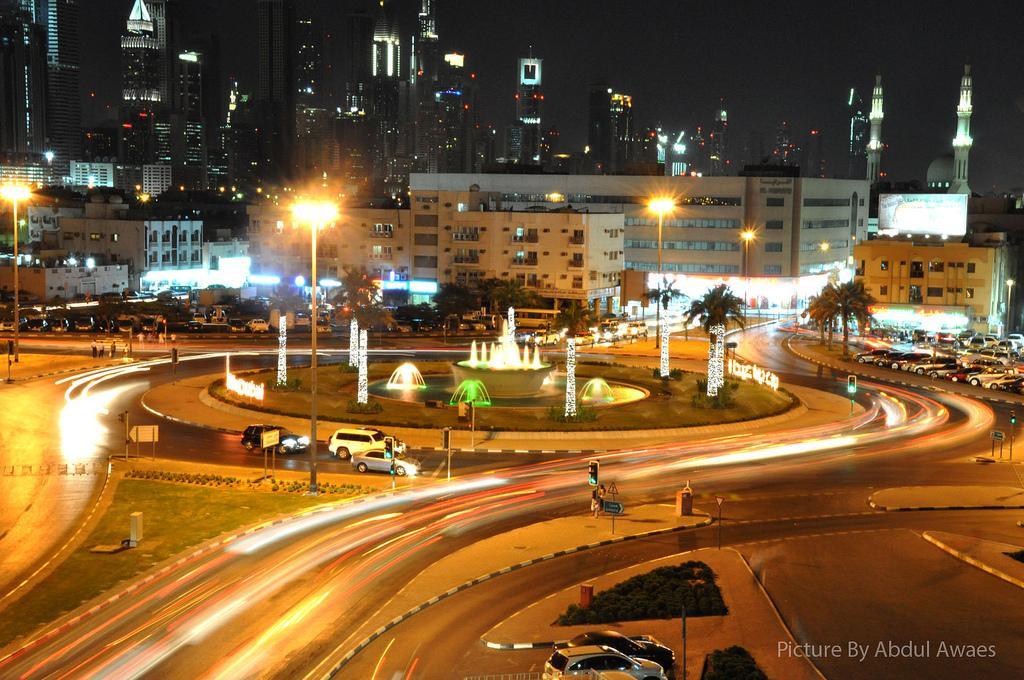
As shown in the image above, the government has done a lot to expand the roundabout as a way of making it easy for vehicles to move with ease. However, it is evident that in cases of heavy traffic, motorists will have to be stopped from time to time to enable other road users to have their way. Such problems arise during peak hours of the morning and evening when people are moving to and from work.
Traffic Flow Theory
Hammond and Wellington (2013) define traffic flow theory as “the study of interactions between travelers and infrastructure (including highways, signage, and traffic control devices), with the aim of understanding and developing an optimal transport network” (p. 56). This theory seeks to develop an efficient movement of traffic, especially in major urban centers, with the primary goal of eliminating the problem of traffic congestion. The theory is critical in defining what needs to be done by relevant authorities to improve road transport network.
Research Hypothesis
The review of the literature shows that traffic congestion is becoming increasingly problematic in major urban centers both in the developed and developing economies. It was important to develop research hypotheses based on the preliminary information obtained from secondary sources. The following are the hypotheses that the researcher seeks to confirm through collection and analysis of primary data.
- H1: Increased numbers of cars, poor ethics among drivers, and some outdated road mapping and architecture are some of the leading causes of traffic in Dubai.
- H2: Traffic has serious psychological, physiological, and financial impact on road users.
- H3. Flexible working hours have an effect of reducing traffic on Dubai roads, especially during the off-peak hours.
Methodology
Data used in this study came from both primary and secondary sources. Secondary data sources came from books, journal articles, and reliable online sources. The information obtained from secondary data sources provided background information for the study. It also helped in addressing identifying the research gaps in this field of study. Data from primary sources was collected from a sample of respondents.
Primary Data Collection
According to Stokes and Wall (2014), it is important for researchers to understand their responsibility when conducting an investigating on a specific issue in a given area. A researcher must understand that one of the cardinal goals of any study is to address the existing gaps and contradiction in knowledge. That can only be done through the collection of primary data. It is only through going to the field and assessing the current situation that one can investigate the existing problem and propose meaningful solutions. As such, it was important to collect primary data. The primary data collection was done in two ways. First, researchers took time to use the local roads in Dubai to identify the possible causes of the problem. Other than relying on information from third parties, the researchers experienced the problem and outline the observed causes of traffic. The second stage was to interview a sample of respondents to shed more light on the causes of the problem and to outline possible solutions.
Instrument of Data Collection
The researcher intends to develop a questionnaire used in the process of primary data collection. According to Hammond and Wellington (2013), a questionnaire helps in standardizing the approach used in collecting data. It ensures that respondents answer specific questions. The instrument is also important when collecting data meant for quantitative analysis. Using structured questions, it is possible to assign statistical values to the responses of the participants. These values were coded for analysis. The questionnaire was administered through face-to-face interviews. Each researcher was assigned a specific number of respondents that must be interviewed within the period available for the investigation.
Sampling and Sample Selection
Primary data was collected from drivers, commuters who use Dubai roads regularly, and government agents working for the Roads and Transport Authority. Given that the respondents were classified into three different categories, the most appropriate sampling technique was stratified sampling (Stokes & Wall, 2014). The researchers identified participants in each stratum through simple random sampling. The target was to have 50 participants in the study. 20 participants were the drivers, 20 were commuters, and 10 were RTA employees.
Procedure
After developing research questionnaire, the researchers formed three groups. The first group was assigned the task of contacting drivers and collecting data from them based on the developed questions. The second group targeted commuters who regularly use Dubai roads as passengers. The first two groups needed no permission from any authority to collect the needed data after this proposal and questionnaire is approved. The last group visited RTA and requested its management to allow their employees to take part in the study. After singling out the individuals who can take part in the project, the goal and nature of the study was explained to them. They were informed about their role and its significance to the research. The researchers reminded them that their identity will remain anonymous in line with the ethical requirements. Data was only be collected from those who were willing and ready to take part in the study.
Analysis of Primary Data
After collecting primary data, the next phase was to conduct the analysis. The researchers intend to use both qualitative and quantitative research design. Quantitative analysis helped in explaining the magnitude of the impact of traffic in this city. Creswell (2014) explains that such analysis helps in answering the question of to what extent does a given independent variable affects a dependent variable. The outcome of the analysis of data quantitatively was presented in the forms of graphs and charts. On the other hand, qualitative research design facilitated a detailed explanation of the nature of the problem and how it can be addressed. It means that the questions that were used in data collection should be both structured and unstructured.
Findings and Discussion
Findings
Causes of traffic in Dubai
In this section, the researcher focused on analyzing primary data from the respondents. The respondents were asked if they think traffic in Dubai is caused by an internal problem. Figure 2 below shows their response.
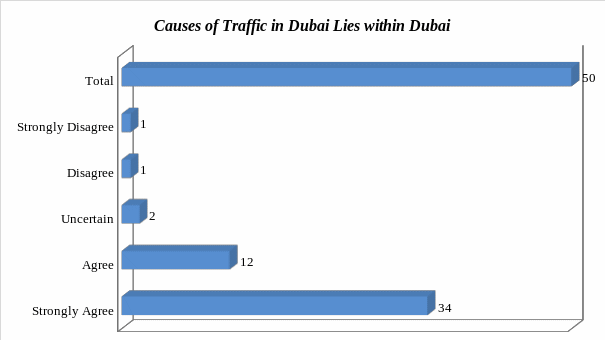
Majority of the respondents (34 out of 50) strongly agree with the statement. Another significant minority agreed with the statement. Only two participants had a contrary opinion. It means that the hypothesis below was confirmed.
H1: Increased numbers of cars, poor ethics among drivers, and some outdated road mapping and architecture are some of the leading causes of traffic in Dubai
It was necessary to determine if roundabout, identified as one of the causes of traffic congestion, is better than a traffic light. The findings show that although both are undesirable, roundabouts are better than traffic lights at T-junctions. Figure 3 below shows the views of the respondents.
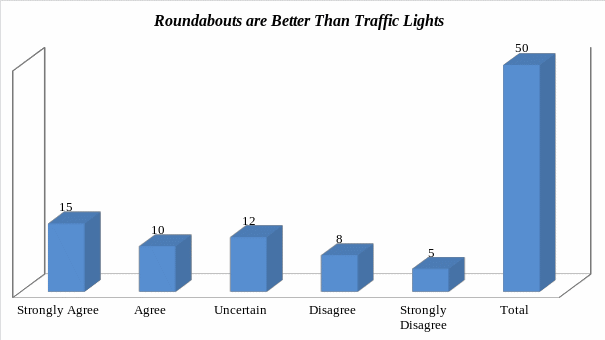
The researchers also wanted to determine if exits and entrances to and from highways are structured inefficiently, leading to traffic congestion. Figure 4 below shows the outcome of the analysis of their response. It is clear that the majority feels that these exits and entrances are poorly designed.
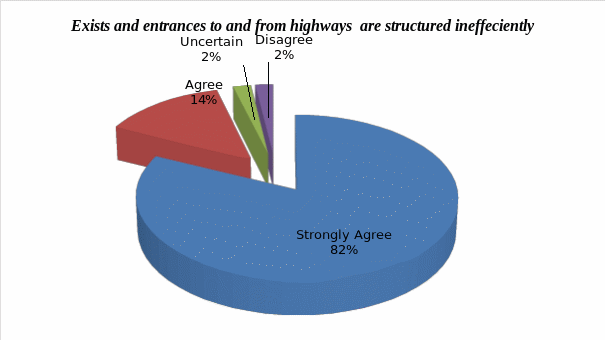
Impact of traffic in Dubai
After identifying the primary causes of traffic congestion in Dubai, it was necessary to determine the impact of the problem. When asked whether heavy traffic affects their lives, the response obtained from the participants is shown in figure 5 below.
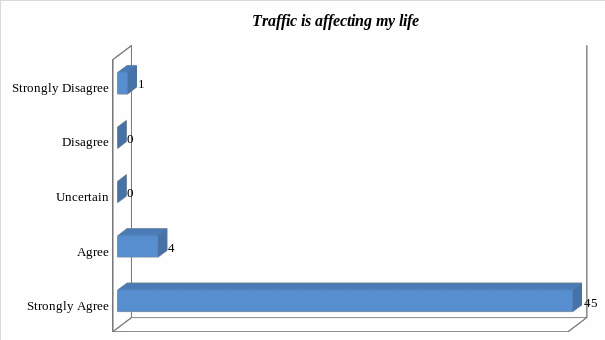
An overwhelming majority (98%) of the respondents stated that traffic congestion has negative consequences on their lives. Only 2% of the respondents had a contrary opinion. It means that the hypothesis below was confirmed.
H2: Traffic has serious psychological, physiological, and financial impact on road users
Ways of managing traffic in Dubai
It was important to identify ways in which the problem of traffic congestion in Dubai can be managed. Respondents were asked if they think the Dubai Metro cam help address the problem. Figure 6 below shows their response.
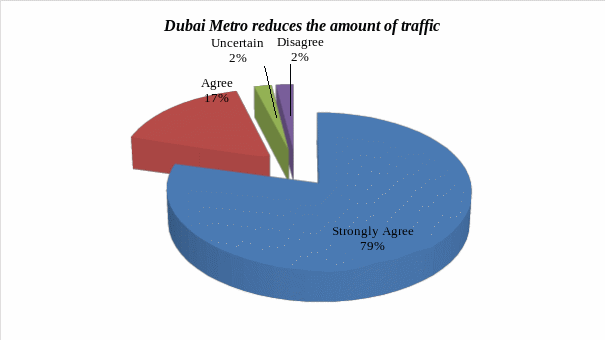
The response shows that the majority of the respondents (96%) believe that Dubai Metro can help in addressing the problem. They also stated that having flexible working hours can help in addressing traffic congestion during rush hours, which means that the hypothesis below was confirmed.
H3. Flexible working hours have an effect of reducing traffic on Dubai roads, especially during the off-peak
Finally, the researcher wanted to determine from the respondents if bridges and tunnels can help address the problem. Fig. 7 below shows their response. The majority believe that such infrastructural improvements can reduce traffic congestion.
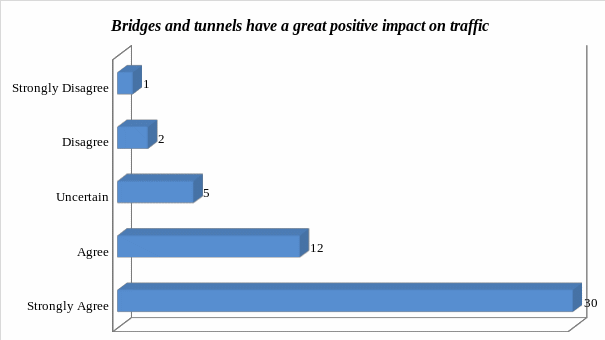
Discussion
Dubai is currently the regional business hub in the Middle East and North Africa (MENA) region. Dempsey (2014) explains that numerous companies have set up their businesses in this city because of its strategic location. It means that it is common to find large trucks using the roads both in the day and at night. The number of these large trucks has been increasing over the recent past. Although the government promotes the use of rail transport when transporting cargo, there are places which are not accessible through the rail networks, making it necessary to use trucks and trailers. Most of these trucks move at speeds of less than 70 kilometers per hour when loaded. Their speed can drop to as low as 30 kilometers per hour on climbing lanes (Maceda, 2018). When using the same highway as other smaller cars, they can reduce their speed. Their high number on the roads means that the ability of the smaller cars to overtake them is also reduced. The government understood this problem and banned the entry of these large trucks into the central business district at specific hours of the day (Shahbandari, 2018). However, that did not stop the problem they pose on highways and other roads away from the city’s central business district.
Zebra crossing is crucial to facilitate movement of the pedestrians across the roads. Shahbandari (2018) explains that this concept was developed to ensure that pedestrians could only cross the road at designated places. It is convenient for motorists, especially in cities and urban centers with a relatively high population. Instead of having passengers crossing the road at any place they consider necessary, they are restricted to a specific place. However, Mould (2015) argues that just like the roundabout, the concept of zebra-crossing is becoming irrelevant. Developed countries are replacing it with pedestrian flyovers to eliminate cases where traffic is forced to stop regularly at the zebra-crossing. In the morning and evening when the number of motorists on the road is high, a two-minute stoppage of the vehicles can cause a serious road snarl-up. The problem can be escalated in major cities where the population of pedestrians is as high as the number of motorists.
Speed bumps are also becoming a serious problem to motorists, especially on freeways. It is important to regulate the speed at which motorists move as a way of curbing accidents in the country. The speed limit varies from one place to another. In many cases, speed bumps are used to slow-down motorists, including those who are likely to break the speed limit laws when there are no barriers. Dempsey (2014) explains that these bumps are common at a zebra crossing. Although they are necessary, it may be necessary to find alternative ways of addressing the problem of over speeding. In a study conducted by Mould (2015), speed bumps are some of the leading causes of traffic jams around the world. The problem is that a driver will be required to start slowing their vehicles about 100 meters away from these physical speed regulators, especially if it is a large truck. Cars coming from behind will be forced to slow their speed even if they are not yet at the 100-meter mark. The ripple effect of the reduction of speed can be felt several kilometers from the bumps, especially on major highways. The problem has led to the elimination of the bumps in various cities around the world. Using effective road signs and strict implementation of the law is becoming a better alternative.
The Roads and Transport Authority has specific regulations that motorists must observe to ensure that their vehicles are roadworthy. However, it is not easy for the law enforcers to identify cars which have serious engine problems. Sometimes the problem may arise when the vehicle is on the highway, making it to stall. Engine failure is a common problem, especially when a car is not taken through a regular service. When such a scenario arises, it will force the driver to find a way of towing the car from the road to a garage. Abdelfatah et al. (2015) explain that there are some locations that may take a while for the towing service to arrive. Within that time of waiting for the solution, the lane that was being used by the stalled vehicle will be closed. It means that if the road was relatively small meant for one vehicle coming in the opposite direction, and only one lane will be available to serve all cars using the road. It means that motorists from each direction will have to be stopped periodically to facilitate fair use for both sides. Such problems have been witnessed in some of the roads in the industrial area. Figure 8 below is an image of a driverless metro train that is operated by the Serco Group.
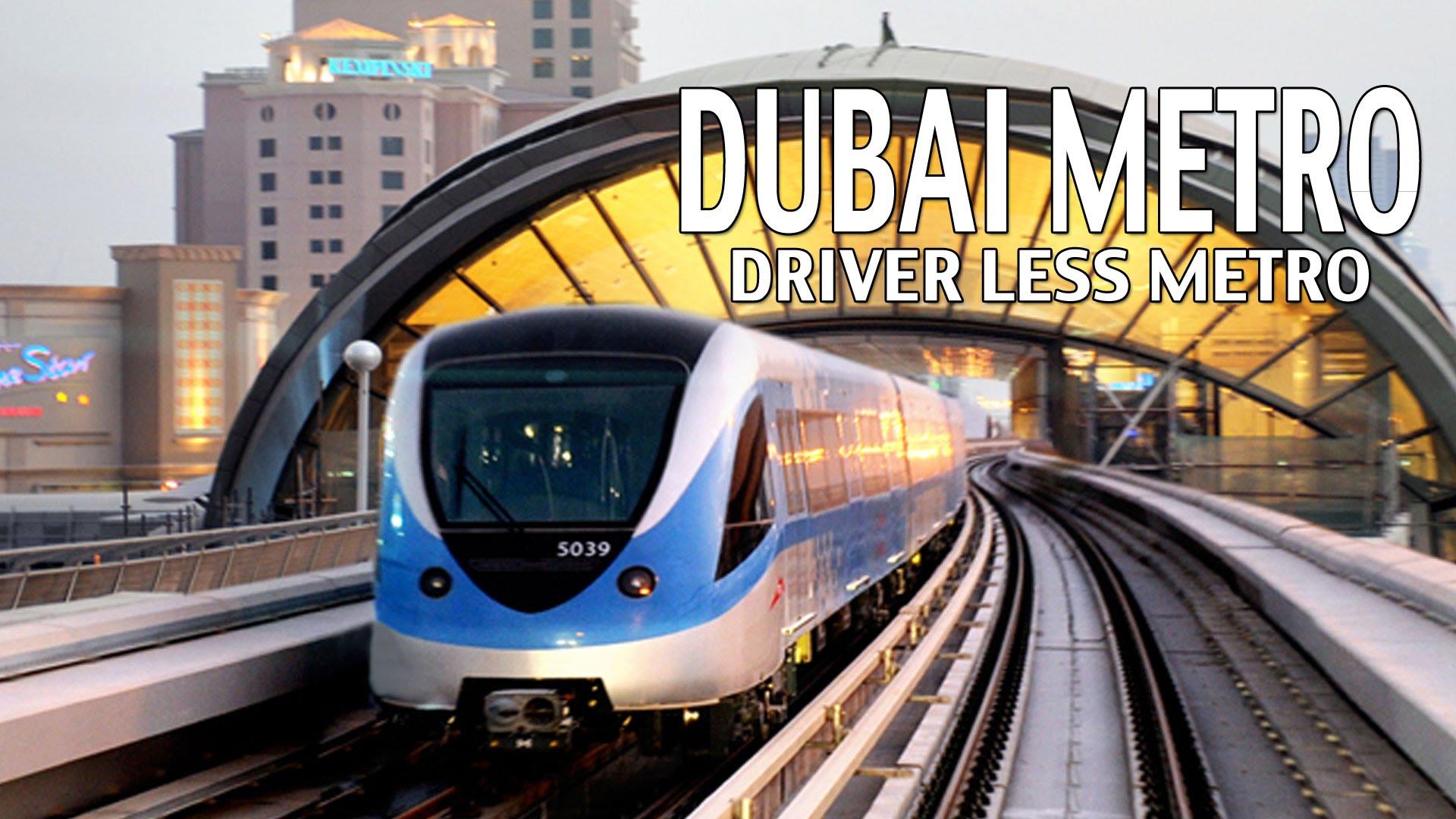
Abdelfatah et al. (2015) argue that the government should promote the use of public transport system. People should be convinced to reduce the use of personal cars, especially when going to work. Dempsey (2014) also recommends the elimination of t-junctions and reduction of roundabouts as a means of reducing road snarl-ups. The government should also redefine the current road mapping and architecture based on the emerging needs. Replacing of zebra-crossings with flyovers can also eliminate unnecessary stops of the traffic. Members of the public, especially the drivers, should also be sensitized about the importance of being responsible when using the roads. They should embrace the lane discipline at all times.
One of the best ways of addressing the problem of traffic congestion is to promote the use of the Dubai Metro. According to Mould (2015), the Dubai Metro is one of the most sophisticated railway systems in the world. The system has two lines to ensure that at each time, passengers can easily be carried in two opposite direction. It has 49 stations (20 on the green line and 29 on the red line) to ensure that it can serve as many people as possible living in different parts of the city (Shahbandari, 2018). The railway line was constructed to ensure that it serves most parts of the city, especially the industrial areas, the central business district, and the highly populated estates. The system, which stretches 74.6 kilometers, is unique in many ways. Abdelfatah et al. (2015) explain that one of the factors that make the metro system unique is that the trains are fully electric and automated. They are driverless, which means that their operations are controlled remotely by a computer. The advanced nature of the system means that it is precise in time-keeping and very efficient. Seats inside the train are also comfortable. It is also important to note that these trains are a lot faster than cars and buses, and can carry hundreds of passengers in one trip. These are attributes that should be appealing to as many travelers as possible.
Limitations
It is important to appreciate the possible limitations that may be faced in the study. One of the main areas of concern is misleading information from some participants. When trying to investigate the local driving culture, some drivers who know that they often break the law may avoid stating so to protect a personal image. It is expected that the strategy of collecting data from a different category of people may help in addressing this problem. There is also the issue of limited time for data collection. Dividing the work and assigning it to different individuals is meant to address this problem. It is also expected that the some of the respondents may have limited knowledge about the complex mapping and road architecture, including the appropriate designs for exits and entrances into the highway. The experts from RTA may help in addressing the problem.
Conclusion and Recommendations
Traffic congestion is reducing the attractiveness of road networks in the city of Dubai. RTA, which is the body charged with the responsibility of operating the system, should come up with initiatives that will attract more customers from the road to the rail system. Promotional campaigns may be necessary. It is necessary to reduce the number of people using road transport because of the existence of a more efficient metro system. When the number of people is reduced from the roads, it will be possible to lessen the problem of traffic jams in the country. The following are the recommendations that should be considered to address this problem.
- Serco Group should use mass and social media to compare benefits and disadvantages of road and rail services. They should emphasize on speed, comfort, efficiency, and safety as some of the basic features that make rail transport more efficient than the use of the road.
- Another initiative that can be taken by the government is to reduce the cost of rail transport. Other than efficiency, the other factor that defines the decisions that travelers make is the pricing. Given that the trains carry over ten times the number of those that can be carried by bus the benefits of economies of scale should make it possible to lower the prices of train tickets.
- The management of RTA should consider embracing emerging technologies when designing and developing new roads, or improving the existing ones, to eliminate T-junctions, unnecessary zebra crossing, and bumps on highways.
References
Abdelfatah, A., Al-Zaffin, M., & Hijazi, W. (2015). Trends and causes of traffic accidents in Dubai. Journal of Civil Engineering and Architecture, 9(1), 225-231. Web.
Creswell, J. (2014). Research design: Qualitative, quantitative, and mixed methods approaches (4th ed.). London, England: SAGE Publication.
Dempsey, M. C. (2014). Castles in the sand: A city planner in Abu Dhabi. Jefferson Township, NC: McFarland & Company.
Gremm, J., Barth, J., Fietkiewicz, K. J., & Stock, W. G. (2017). Transitioning towards a knowledge society: Qatar as a case study. London, England: Springer.
Hammond, M., & Wellington, J. (2013). Research methods: The key concepts. New York, NY: Taylor &Francis Group.
Maceda, C. (2018). Congested cities: Dubai drivers spend 29 hours stuck in traffic.Gulf News. Web.
Mould, O. (2015). Urban subversion and the creative city. New York, NY: Routledge.
Shahbandari, S. (2018). Dubai’s traffic travails: In-depth look.Gulf News. Web.
Stokes, P., & Wall, T. (2014). Data Analysis and Interpretation. London, England: Palgrave Macmillan Publishers.